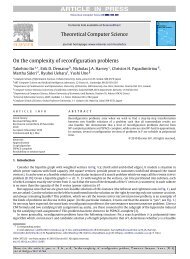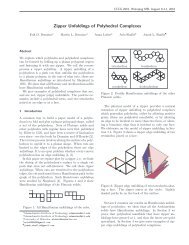Algorithmic Folding Complexity - Erik Demaine
Algorithmic Folding Complexity - Erik Demaine
Algorithmic Folding Complexity - Erik Demaine
Create successful ePaper yourself
Turn your PDF publications into a flip-book with our unique Google optimized e-Paper software.
<strong>Algorithmic</strong> <strong>Folding</strong> <strong>Complexity</strong>Jean Cardinal ∗ <strong>Erik</strong> D. <strong>Demaine</strong> † Martin L. <strong>Demaine</strong> ⋆⋆ Shinji Imahori ‡Stefan Langerman ⋆§ Ryuhei Uehara Abstract. How do we most quickly fold a paperstrip (modeled as a line) to obtain a desiredmountain-valley pattern of equidistant creases(viewed as a binary string)? Define the folding complexityof a mountain-valley string as the minimumnumber of simple folds required to construct it. Weshow that the folding complexity of a length-n uniformstring (all mountains or all valleys), and henceof a length-n pleat (alternating mountain/valley), ispolylogarithmic in n. We also show that the maximumpossible folding complexity of any string oflength n is O(n/ lg n), meeting a previously knownlower bound.(a) How fast can we fold this?1. Introduction. What is the best way to fold anorigami model? Origamists around the world strugglewith this problem daily, searching for clever,more accurate, or faster folding sequences and techniques.Many advanced origami models require substantialprecreasing of a prescribed mountain–valleypattern (getting each crease folded slightly in thecorrect direction), and then folding all the creasesat once. For example, in his instructional videofor folding the MIT seal Mens et Manus in “threeeasy steps” [3], Brian Chan spends about three hoursprecreasing, then three hours folding those creases,and then four hours of artistic folding. The precreasingcomponent is particularly tedious, leading us toa natural algorithmic problem of optimal precreasing:what is the fastest way to precrease a givenmountain–valley pattern? Although the standardmethod of “fold one crease, unfold, repeat” is usuallythe most accurate, it might be possible to foldthe paper along some of the desired creases to bringseveral other desired creases into alignment, and∗ Département d’Informatique, Université Libre deBruxelles (ULB), CP 212, B-1050 Brussels, Belgium,{jcardin,stefan.langerman}@ulb.ac.be.† Computer Science and Artificial Intelligence Laboratory,Massachusetts Institute of Technology, Cambridge, MA 02139,USA. {edemaine,mdemaine}@mit.edu‡ Graduate School of Information Science and Technology,University of Tokyo, Tokyo 113-8656, Japan. imahori@mist.i.utokyo.ac.jp§ Maître de recherches du F.R.S.-FNRS School of Information Science, Japan Advanced Institute ofScience and Technology (JAIST), Ishikawa 923-1292, Japan. uehara@jaist.ac.jp(b) An origami angel with many pleats, folded byTakashi Hojyo (reproduced with his kind permission).Figure 1: Pleats.thereby precrease them all at once.We focus here on a simple kind of onedimensionalprecreasing, where the piece of paper isa long rectangular strip, which can be abstracted intoa line segment, and the creases uniformly subdividethe strip. A mountain-valley pattern is then simplya binary string over the alphabet {M, V } (M formountain, V for valley), which we call a mountainvalleystring. Of particular interest in origami is thepleat, which alternates MV MV MV · · · ; see Figure1.2. Our Results. In this paper, we develop surprisinglyefficient algorithms for precreasing a1
mountain-valley string, especially the pleat.First, we show how to fold a uniform mountain–valley string MMM · · · of n mountain creases usingjust O(lg 1+√2 n) simple fold operations. Theseoperations fold only along desired creases, and thelast direction that each crease gets folded is mountain.By combining two executions of this algorithm,we obtain the same bound for pleats. Thisfolding is exponentially faster than both the standardfolding and the best known folding of O(n ε )folds [7]. From a complexity-theoretic perspective,this is the first polynomial-time algorithm for pleatfolding, because the only input is the number n.Second, we show how to fold an arbitrarymountain–valley string of n creases using justO(n/ lg n) folds. This algorithm is the first to beatthe straightforward n − 1 upper bound by more thana constant factor, and is asymptotically optimal [7].We effectively exploit that every string has some redundancyin it, similar to how Lempel-Ziv can compressany string into O(n/ lg n) block pointers.Unfortunately, our algorithms are not about torevolutionize pleat folding or other practical paperprecreasing, because they assume ideal zerothicknesspaper. In reality, folding more than afew layers of paper leads to some inaccuracy inthe creases, called creep in origami circles, andour algorithms require folding through Θ(n) layers.Nonetheless, our results lead the way for the developmentof practical algorithms that limit the numberk of layers that can be folded through simultaneously,with speed increasing as k grows.From an information-theory perspective, paperfolding offers an intriguing new definition of the algorithmiccomplexity of a binary string. The foldingcomplexity [7] of a mountain–valley string isthe minimum number of folds needed to constructit. Similar to how Kolmogorov complexity compressesa string down to instructions for a Turingmachine, folding complexity compresses a stringdown to instructions for an origamist. Unlike Kolmogorovcomplexity, however, folding complexityis computable, though its exact computational complexity(between P and EXPTIME) remains open.We lack a specific (deterministic) string whose foldingcomplexity is asymptotically the maximum possible.(The pleat was an early candidate, now knownto be far from the worst case.) Nonetheless, our resultsshed some light on the structure of this newmeasure.3. Related Work. Uehara [6] posed the problemwe tackle here in August 2008. In March 2009,Ito, Kiyomi, Imahori, and Uehara [7] formalizedthe problem and made some partial progress. Onthe positive side, they showed how to fold anymountain–valley string using ⌊n/2⌋ + ⌈lg(n + 1)⌉folds, a bound we improve on by a logarithmic factor;and they showed how to fold the uniform stringand hence a pleat using O(n ε ) folds, for any ε > 0. 1On the negative side, they showed that almost everymountain–valley string requires Ω(n/ lg n) folds usingan information-theoretic argument. We tightenthis lower bound to prove that a lead constant factorof 1 suffices, reasonably close to our asymptoticallymatching upper bound which has a lead constantfactor of 4 + ε, for any ε > 0.About n different mountain–valley strings oflength n can be folded using the absolute minimumnumber of folds, ⌈lg(n + 1)⌉. These strings arecalled paper folding sequences and have been studiedmuch earlier [8, 4, 1].Acknowledgments. This work was initiated at theWAFOL’09 workshop in Brussels. We thank all theother participants, as well as Guy Louchard, for usefuldiscussions.References.[1] Jean-Paul Allouche. Sur la complexité des suites infinies.Bull. Belg. Math. Soc., 1:133–143, 1994.[2] Esther M. Arkin, Michael A. Bender, <strong>Erik</strong> D. <strong>Demaine</strong>,Martin L. <strong>Demaine</strong>, Joseph S. B. Mitchell,Saurabh Sethia, and Steven S. Skiena. When can youfold a map? Comput. Geom. Theory Appl., 29(1):23–46, 2004.[3] Brian Chan. The making of Mens et Manus (inorigami), vol. 1. http://techtv.mit.edu/collections/chosetec/videos/, March2007.[4] Michel Dekking, Michel Mendès France, Alf van derPoorten. Folds! Math. Intell., 4:130–138, 173–181,190–195, 1982.[5] <strong>Erik</strong> D. <strong>Demaine</strong> and Joseph O’Rourke. Geometric<strong>Folding</strong> Algorithms. Cambridge University Press,2007.[6] <strong>Erik</strong> D. <strong>Demaine</strong> and Joseph O’Rourke. Open problemsfrom CCCG 2008. In Proc. 21st Canadian Conferenceon Computational Geometry (CCCG’09), toappear, 2009.[7] Tsuyoshi Ito, Masashi Kiyomi, Shinji Imahori, andRyuhei Uehara. <strong>Complexity</strong> of pleat folding. InProc. 25th Workshop on Computational Geometry(EuroCG’09), 53–56, 2009.[8] M. Mendès France and A. J. van der Poorten. Arithmeticand analytic properties of paper folding sequences.Bull. Austr. Math. Soc., 24:123–131, 1981.1 A somewhat more careful analysis shows that the same algorithmuses 2 O(√ lg n lg lg n) folds.2
















